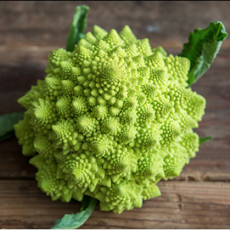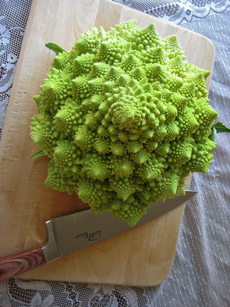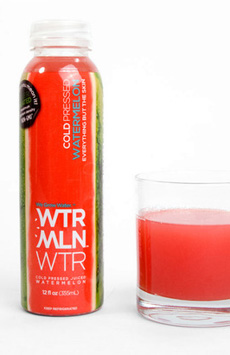|
Isn’t it beautiful?
Romanesco looks like it’s been sculpted by an artist. It’s a member of the cruciferous vegetables family (Brassicaceae) that includes broccoli and cauliflower, among others. If it seems exotic, that’s because we rarely find it in U.S. markets. But romanesco grown in California is in season now.
In the U.S., it’s also called broccoflower, Roman broccoli, romanesco broccoli, romanesque cabbage and romanesque cauliflower. So is it broccoli or cauliflower? Actually, it’s neither.
Remember high school botany taxonomy: kingdom, order, family, genus, species and sometimes, subspecies?
The Brassica genus is unusual in that instead of individual species, it bundles its members into one species.
Thus, the species Brassica oleracea includes broccoli, Brussels sprouts, cabbage, cauliflower, collard greens, kale, kohlrabi, mustard, rapeseed/canola, rapini (broccoli rabe) and turnips.
What might be called a subspecies elsewhere are known here as cultivars, and don’t have a separate botanical name*.
So the answer is: romanesco is neither broccoli nor cauliflower; it is its own cultivar. While you’ll see it called broccoli or cauliflower, you now know better.
Botanists believe that Italian farmers in the 16th century developed romanesco through cross-breeding. It was initially called broccolo romanesco.
As with cauliflower or broccoli, the pointy “florets” (often called fractals after fractal art) that comprise the head are of varying sizes. They are actually individual buds of the plant’s flower.
Romanesco tastes more like cauliflower, with a nutty, earthy flavor nuance and a crunchier texture.
It is about the same size of a regular head of cauliflower. There is also a smaller variety, which is about half the size. The pale green shade keeps its color through cooking.
|
|

[1] If you can’t find it locally, order romanesco online as a special treat (photo © Good Eggs).

[2] Cooked romanesco florets (photo © Grub Market).
|
Look in your farmers markets or specialty produce stores; the crops from California are in. You can treat yourself or send a gift from Melissas.com.
|

[3] It’s almost to pretty to cut! Enjoy it as a centerpiece for a day or two. Photo courtesy SimplyMcGhie.Blogspot.com. |
|
HOW TO SERVE ROMANESCO
Romanesco can be served raw, lightly cooked, or cooked through, and can be substituted in any recipe calling for cauliflower or broccoli.
It’s a shame to destroy the architecture by dicing or puréeing.
We wouldn’t want to turn it into soup, for example, when we could use regular cauliflower.
Instead, consider:
Crudités
Lightly steamed (recipe)
Marinated
Mixed vegetable salads (with mixed greens or other vegetables)
Roasted
Sautéed (here’s an easy recipe with garlic, olive oil and Parmesan cheese)
|
RECIPE #1: ROMANESCO SALAD
This recipe is from Mariquita Farm of Watsonville, California (alas, now closed), which grew romanesco for many years.
Ingredients
1 head romanesco
1/4 cup Kalamata or other favorite olive, pitted and sliced
Capers, 1 tablespoon per 4 cups of florets
1/4 cup chopped onion or to taste: green onion, red onion, shallot
Fresh herbs, chopped (basil, cilantro and/or parsley are our favorites here)
Lemon juice vinaigrette (recipe below)
Salt and pepper to taste
Optional: shaved Parmesan or crumbled Gorgonzola
Optional garnish: toasted sunflower seeds
Preparation
1. LIGHTLY STEAM the florets to desired consistency. While you can use them raw, a blanching or light steaming makes the texture more uniform with the other ingredients.
2. TOSS with the other ingredients and the vinaigrette, taking care not to damage the pointy “fractals.” Serve chilled or at room temperature.
RECIPE #2: LEMON VINAIGRETTE
Ingredients
2 tablespoons freshly-squeezed lemon juice
1/2 teaspoon lemon zest
1/2 teaspoon Dijon mustard
1/8 teaspoon sugar
4 tablespoons extra-virgin olive oil
1/4 teaspoon salt, or to taste
Salt and freshly ground black pepper to taste
Preparation
1. WHISK together the lemon juice, zest, mustard, sugar and salt in a small bowl. Add the olive oil in a slow stream, whisking constantly until the dressing is well blended.
2. TASTE and season with additional salt and pepper as desired. Drizzle over the salad and toss to coat thoroughly.
WHY ARE CRUCIFEROUS VEGETABLES SO GOOD FOR YOU?
The Brassicaceae family of vegetables contains powerful antioxidants that prevent the build-up of free radicals, atoms with unpaired electrons in the body that are destructive, engendering disease.
Along with their nutritional elements, cruciferous vegetables aid with alkalinization (making the body less acidic), bone health, cancer prevention, cholesterol reduction and detoxification (neutralization and elimination of unwanted contaminants).
The high fiber content aids in digestion, heart health, lowering blood sugar, reducing allergy reactions and inflammation, and more.
_________________
*Other members of Brassicaceae belong to a different genus. These include arugula, bok choy, Chinese cabbage, cress, daikon, horseradish, mizuna, radish, rutabaga, tatsoi and wasabi.
|
|







